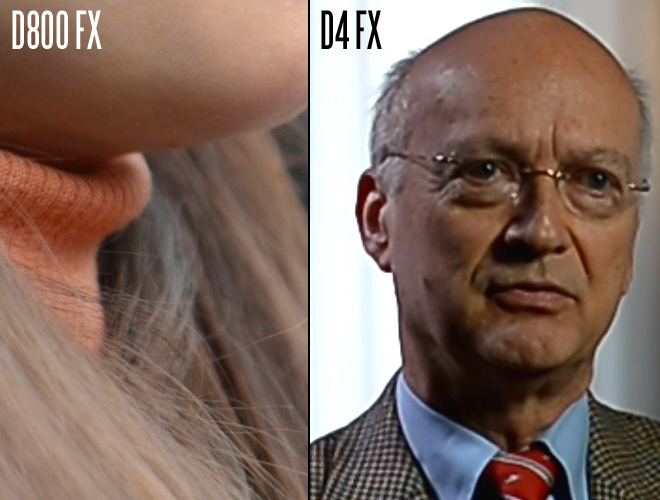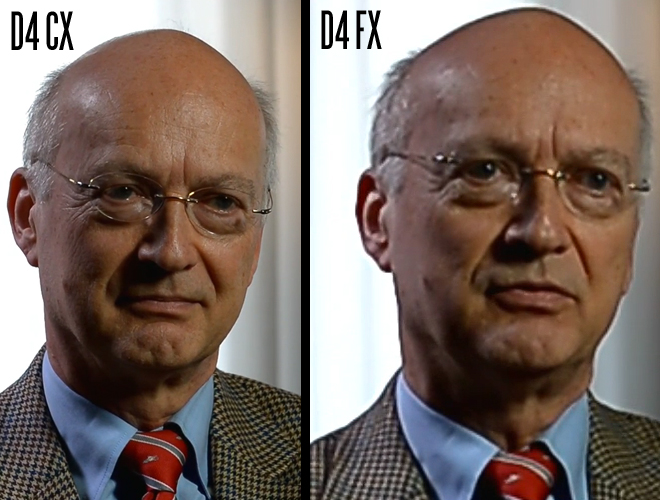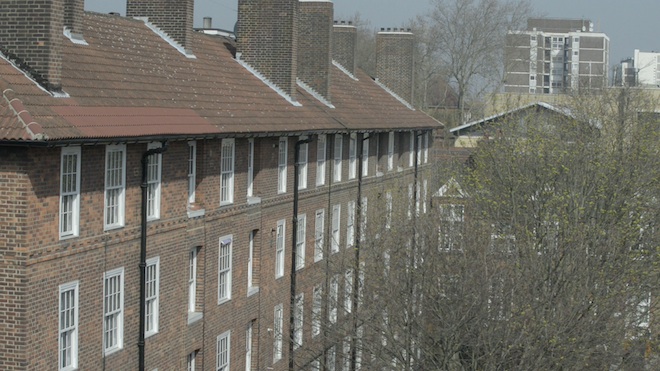
Freelance BBC shooter Johnnie Behiri has had his hands all over the new Nikon DSLRs recently and has been keeping me informed about their pros and cons. The big news here is just how good the Nikon D800’s video with cutting edge Sony sensor is relative to its big brother the D4.
Johnnie didn’t yet have the D800 for the shoot where the image above is taken from but it is obvious the D800 resolves more detail from the full frame sensor in 1080p.

Above: the Nikon D4 gives perfect 1080p in crop mode but the full sensor image is soundly beaten by the consumer level Nikon D800.
The Nikon’s D4 crop mode however is a different story. 1:1 pixel perfect 1080p. But 2.7x only gives you a sensor size equal to the tiny Nikon 1 series CX mirrorless camera.
The 35mm full frame of the Nikon D4 is unbelievably soft with seemingly no attention at the sensor architecture design stage to video. The video output is clearly produced using a very primitive downsampling method and looks awful as a result.
This is a $6000 flagship DSLR.
Nikon D800 takes the video resolution spoils
Now if I were a working pro stills shooter who also needs high quality video on assignment in the field, I’d not be entirely pleased with Nikon over the D4’s crippled video mode. I’d not really want to lug two bodies around with me on public transport or into crowded events either, so the FS100 is out. I would be tempted to save $3000 and get then D800 instead.
The D800’s video output is much closer to the perfect 1:1 crop image of the D4 in 2.7x mode apart from the fact it is doing it in full frame mode!
The resolution is not compromised although there is some aliasing on horizontal lines and false colour moire on very fine fabrics. The issue doesn’t seem as bad as on the Canon 5D Mark II or 7D from what I’ve seen but it is there if you look closely. To be fair though it does not flare up as easily as some cameras do.

The frame grab above (the video seems to have been removed from Vimeo?) is just a very rudimentary D800 test but it doesn’t display any moire on the brickwork. Whilst it is a shame the D800 has a moire issue, it certainly beats the 5D Mark III and D4 hands down for detail and resolution.
This also bodes very well for Sony’s full frame entry later this year. Sony seem to have factored in video to their sensor design to a larger extent than any other apart from Panasonic with the GH2. Their pricing is aggressive (as we’ve seen with the FS100).
Sony have noticed the size of the market for those interested in video on DSLRs at the sub $3000 mark for whom a Sony F3 or Canon C300 is just unobtainable due to the cost, and they are gunning for it.
Does the D800’s pixel count compromise low light video?
The Nikon D800 has a Sony CMOS which has double the resolution for half the money than the D4. Go figure.
But the D4 has a huge advantage in low light, right?
From DXOMark it doesn’t appear so, because although at the native pixel level the smaller pixels in the 36MP D800 are slightly noisier than the D4’s, DXOMark uses printed images as the benchmark rather than a 100% 1:1 crop like typical reviews do.
This method is more closely related to what real-world results would be like.
Like a printed 36MP still, video is also downsampled to fit in a smaller area – in this case quite dramatically from 36MP to 2MP. The result averages noise across individual pixels to create ‘superpixels’ with less noise so the DXOMark score does bode well for the D800’s video mode relative to the low light prowess of the D4 and D3s video output.
Another example of this phenomena can be seen with the GH2’s 1:1 crop mode, which looks noisy at anything above ISO 400 whilst the full sensor’s downsampled video output is pretty clean even at ISO 1250.
Buyer’s advice
Without waiting for NAB or Photokina, if you have to buy now then it is a clear cut choice. If you have loads of Canon lenses get the 5D Mark III because they won’t adapt to a Nikon. If you’re afraid of moire and aliasing get the 5D Mark III because that is free from it and you can adapt any Nikon glass if you have it. If you are afraid of 720p levels of resolution in a faux 1080p mode get the Nikon D800 because it is far more detailed.
Unless moire or low resolution is a killer for your specific work I’d also recommend paying close attention to overall aesthetics and looks of each camera. Go for the DSLR with the nicest feeling image to you personally. This can be a subjective judgement. I prefer the GH2 right now (detailed, fantastic codec, film like noise grain) but I do like full frame and the Canon colours so I have more than one camera.
Me – I am going to wait before I’ve used my 5D Mark III far more before dropping it for the D800. I care deeply about have the best full frame image I can get my hands on and it is not a light decision. I also care deeply about Canon and Nikon delivering the goods on DSLR video and my frustration is that these cameras can and should be even better, which is why my Sony FS100 will arrive next week to go alongside my GH2 and 5D Mark III. The resolution isn’t tolerable on the 5D Mark III for many shots so I have the GH2 and FS100 where I need true 1080p. It also seems to have other issues which I’ve not yet been able to solve like the low ISO codec fizz in the lows (shadow areas). It isn’t a very smooth image sometimes and the encoder seems to be a rather primitive one to my eye. I could be wrong. I hope I am!
Finally – if 2.7x crop is your thing, the D4 produces perfect 1080p
Here’s some of Johnnie’s footage shot with the D4 in 2.7x crop mode. Very nice resolution indeed and no nasties. I am sure it will be pretty noisy at high ISOs but colour and dynamic range seem pretty good. It is just such a shame they neglected the downsampling in full frame video mode. It is unlikely firmware will fix this because downsampling happens at a low level on the hardware.
Big thanks to Johnnie for sharing his hands-on experience with the new Nikons.
[vimeo]http://vimeo.com/39035275[/vimeo]

